Discover 35 hidden attractions, cool sights, and unusual things to do in Winston-Salem (United States). Don't miss out on these must-see attractions: Reynolda House Museum of American Art, Bowman Gray Stadium, and Single Brothers' House. Also, be sure to include Truist Stadium in your itinerary.
Below, you can find the list of the most amazing places you should visit in Winston-Salem (North Carolina).
Table of Contents
Reynolda House Museum of American Art
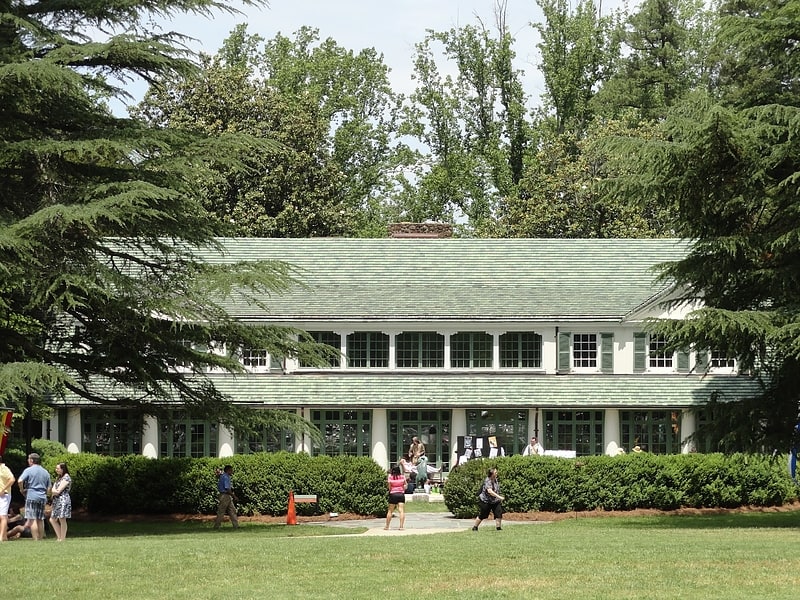
Museum in Winston-Salem, North Carolina. The Reynolda House Museum of American Art displays a premiere collection of American art ranging from the colonial period to the present. Built in 1917 by Katharine Smith Reynolds and her husband R. J. Reynolds, founder of the R. J. Reynolds Tobacco Company, the house originally occupied the center of a 1,067-acre estate. It opened to the public as an institution dedicated to the arts and education in 1965, and as an art museum in 1967. The house holds one of the country's finest collections of American paintings. It is located in Winston-Salem, North Carolina.[1]
Address: 2250 Reynolda Rd, 27106-5117 Winston Salem
Bowman Gray Stadium
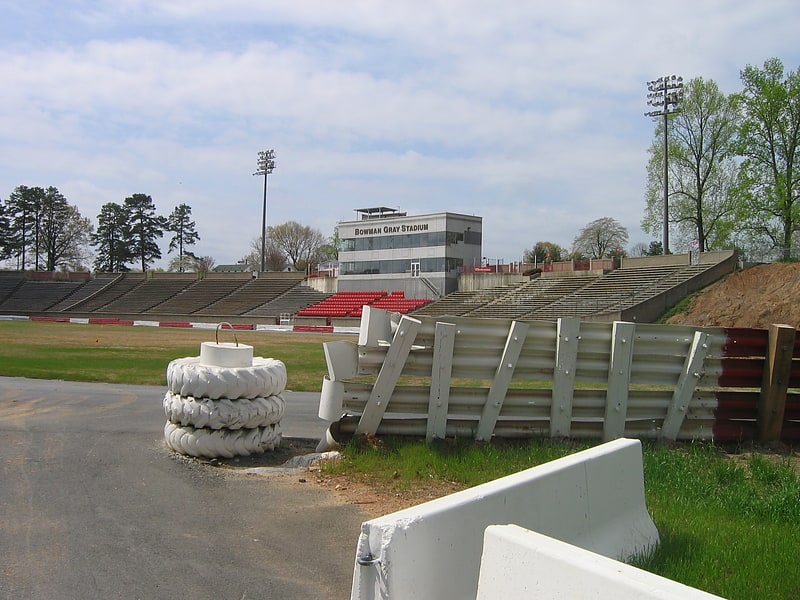
Stadium in Winston-Salem, North Carolina. Bowman Gray Stadium is a NASCAR sanctioned 1⁄4-mile asphalt flat oval short track and longstanding football stadium located in Winston-Salem, North Carolina. It is one of stock car racing's most legendary venues, and is referred to as "NASCAR's longest-running weekly race track". Bowman Gray Stadium is part of the Winston-Salem Sports and Entertainment Complex and is home of the Winston-Salem State University Rams football team. It was also the home of the Wake Forest University football team from 1956 until Groves Stadium opened in 1968. Bowman Gray Stadium was a popular venue for high school football in the 1970s and 1980s. Parkland and R.J. Reynolds High Schools shared Bowman Gray Stadium as their home field for high school football until the two schools built their own facility in 1994.[2]
Address: 1250 S Martin Luther King Jr Dr, 27107-1370 Winston Salem
Single Brothers' House
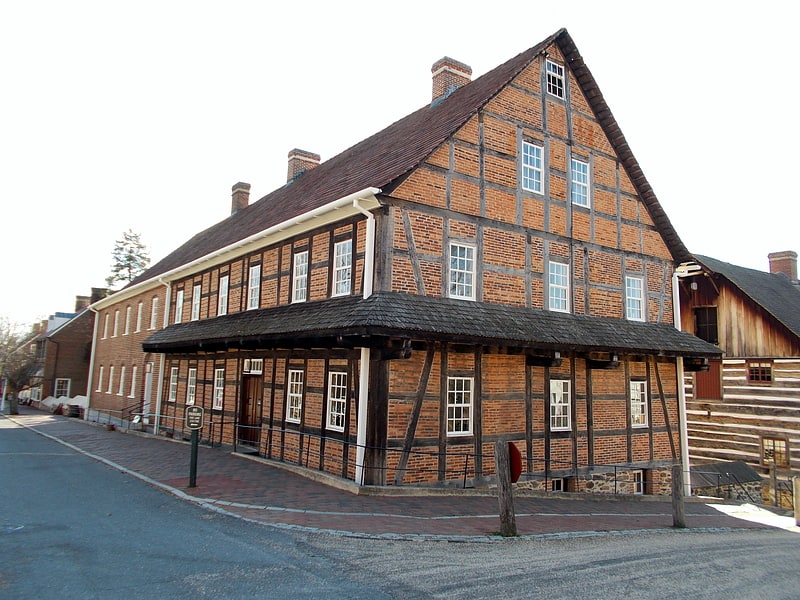
Museum. The Single Brothers' House was built to house the Single Brethren, the unmarried men, of the Moravian Congregation of Salem, now Winston-Salem, North Carolina. It is part of Old Salem Museums & Gardens and open as an Old Salem tour building to visitors. It is located at 600 South Main Street, at Academy Street, on the southwest corner.[3]
Address: 600 S Main St, 27101 Winston-Salem
Truist Stadium
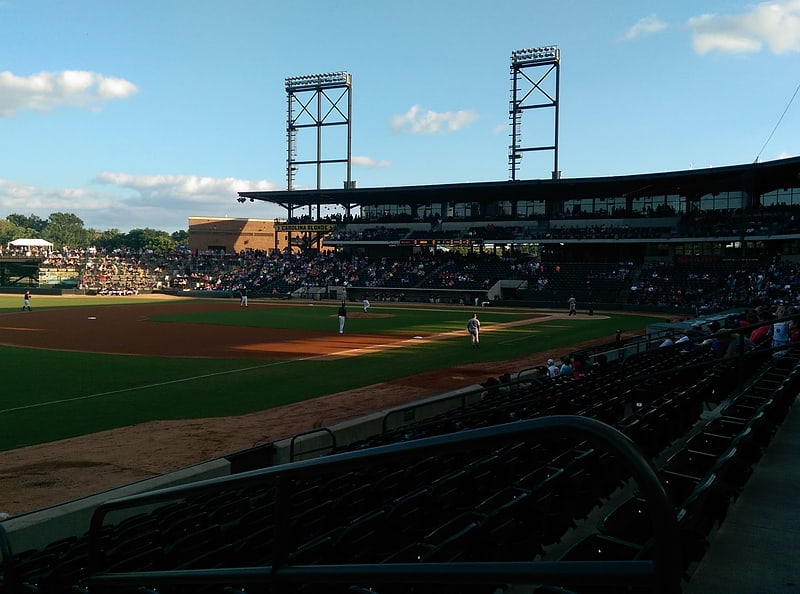
Ballpark in Winston-Salem, North Carolina. Truist Stadium is a ballpark in Winston-Salem, North Carolina that replaced Ernie Shore Field. It is primarily used for baseball, and is the home field of the Winston-Salem Dash minor league baseball team.
The ballpark is bounded by Peters Creek Parkway (northwest/west); 1st Street (north); and Green Street (northeast, left-center field). Salem Parkway, which carries US 158 and US 421, is toward the south/southeast.[4]
Address: Winston-Salem, 951 Ballpark Way
Historic Bethabara Park
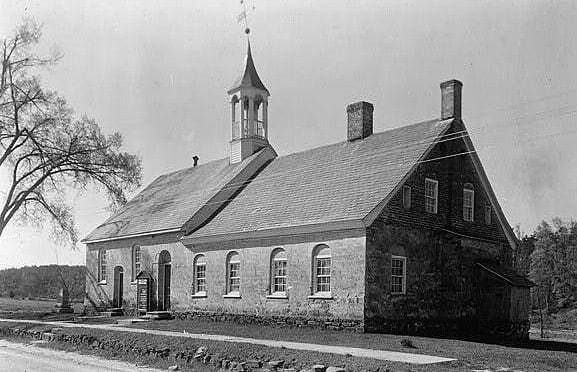
Bethabara Historic District encompasses the surviving buildings and archaeological remains of a small Moravian community, that was first settled in 1753. Located in present-day Forsyth County, North Carolina, it is now a public park of the city of Winston-Salem. It was designated National Historic Landmark in 1999.[5]
Address: 2147 Bethabara Rd, 27106-2701 Winston Salem
Salem Tavern
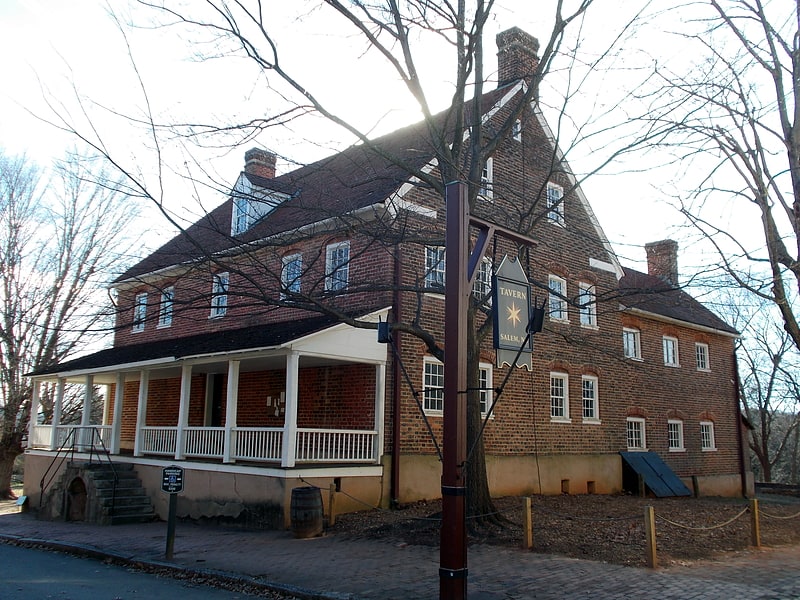
Building in Winston-Salem, North Carolina. Salem Tavern is a historic museum property at 800 South Main Street in Winston-Salem, Forsyth County, North Carolina. It was a tavern in the 18th-century town of Salem, which is now part of Winston-Salem. It is part of Old Salem Museums & Gardens and open as an Old Salem tour building to visitors. Built in 1784 and enlarged in 1815, it was the first entirely brick building in what is now Old Salem, and is one of the oldest surviving brick tavern buildings in the United States. It was declared a National Historic Landmark in 1964.[6]
Address: 736 S Main St, 27101-5331 Winston-Salem
Lawrence Joel Veterans Memorial Coliseum
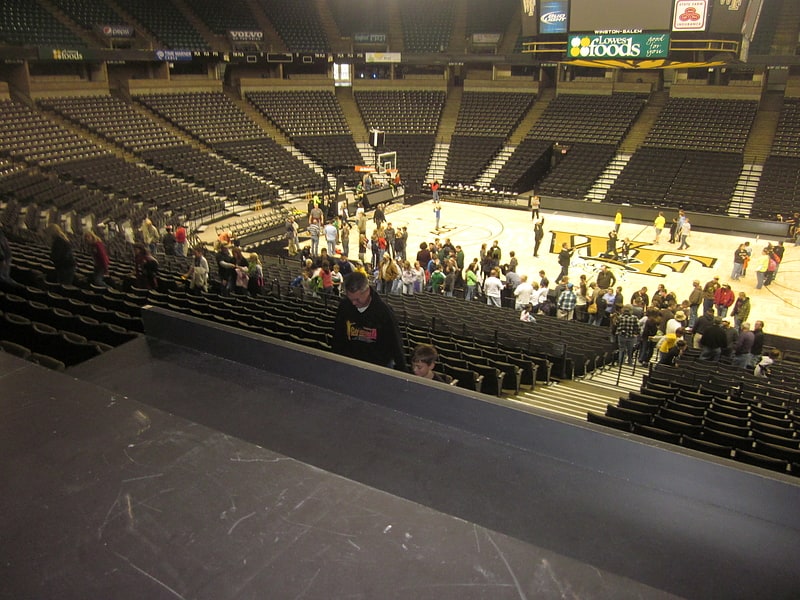
Arena in Winston-Salem, North Carolina. The Lawrence Joel Veterans Memorial Coliseum is a 14,407-seat multi-purpose arena, in Winston-Salem, North Carolina. Construction on the arena began on April 23, 1987 and it opened on August 28, 1989. It was named after Lawrence Joel, an Army medic from Winston-Salem who was awarded the Medal of Honor in 1967 for action in Vietnam on November 8, 1965. The memorial was designed by James Ford in New York, and includes the poem "The Fallen" engraved on an interior wall. It is home to the Wake Forest University Demon Deacons men's basketball and women's basketball teams, and is adjacent to the Carolina Classic Fairgrounds. The arena replaced the old Winston-Salem Memorial Coliseum, which was torn down for the LJVM Coliseum's construction.[7]
Address: 2825 University Pkwy, 27105-4225 Winston Salem
Truist Field at Wake Forest

Truist Field at Wake Forest is a football stadium in Winston-Salem, North Carolina. The stadium is just west of Gene Hooks Field at Wake Forest Baseball Park, home of the Wake Forest baseball team. It is primarily used for American football, and is the home field of the Wake Forest University Demon Deacons. The stadium opened in 1968 and holds 31,500 people. It is the smallest football stadium, by capacity, in both the ACC and in all Power 5 conferences. Previously known as Groves Stadium, in September 2007, Wake Forest University and BB&T, which was headquartered in Winston-Salem, announced a 10-year deal to officially rename the stadium BB&T Field starting with the first 2007 home game against Nebraska. The deal was part of a larger development process to secure funds for stadium renovations and upgrades. On July 8, 2020, the name of the stadium was changed to Truist Field at Wake Forest following a merger between BB&T and SunTrust.[8]
Address: 499 Deacon Blvd, 27105-4216 Winston Salem
Old Salem
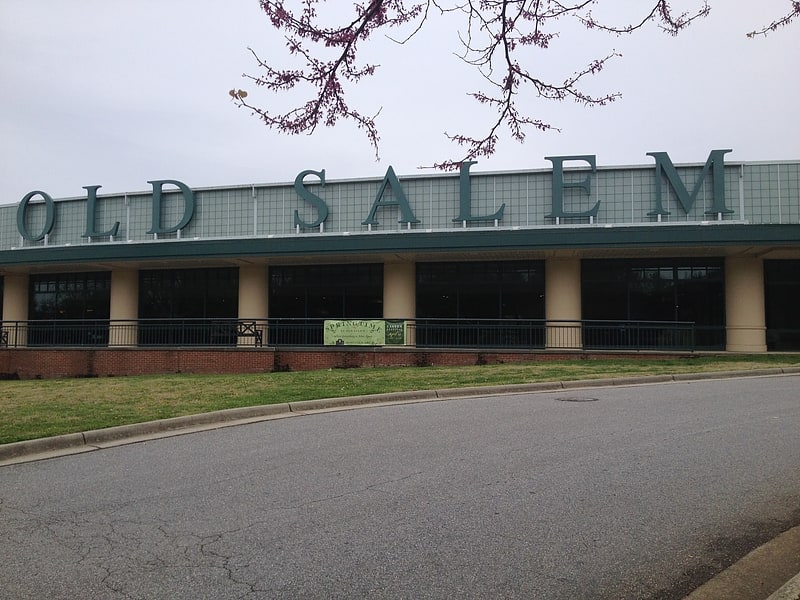
Museum in Winston-Salem, North Carolina. Old Salem is a historic district of Winston-Salem, North Carolina that was originally settled by the Moravian community in 1766. This small city features a living history museum that interprets the restored Moravian community. The non-profit organization began its work in 1950, although some private residents had restored buildings earlier. As the Old Salem Historic District, it was declared a National Historic Landmark in 1966 and expanded in 2016. The district showcases the culture of the Moravian settlement in North Carolina during the 18th and 19th centuries, communal buildings, churches, houses, and shops.
Two buildings are individually designated as NHLs: the Salem Tavern and the Single Brothers' House. Additional buildings and properties have been added to the National Register that expand the historic area (see St. Philips Moravian Church below, Single Brothers Industrial Complex Site, and West Salem Historic District). Ownership of the buildings and land is divided among Old Salem, Inc. Wachovia Historical Society, private owners, Salem College and Academy, and Salem Congregation (the successor to the Salem Congregational Council to whom all ownership of Church properties was transferred).[9]
Wait Chapel
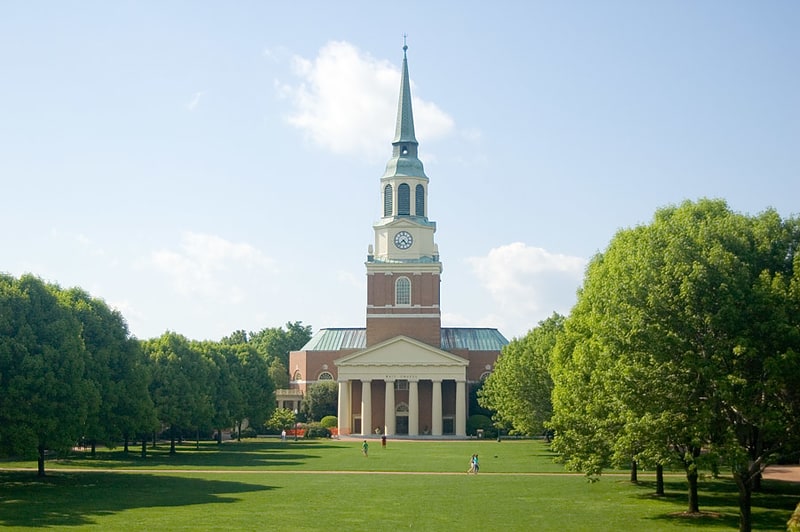
Building in Winston-Salem, North Carolina. Wait Chapel is a building on the campus of Wake Forest University. It houses the Janet Jeffrey Carlile Harris Carillon of 48 bells. The chapel seats 2,250 people. The steeple reaches to 213 feet. It also houses the Williams Organ, donated by Walter McAdoo Williams, namesake of Walter M. Williams High School.
The first building constructed on the Reynolda campus of Wake Forest University, it was named in memory of Samuel Wait, the university's first president, in October 1956.
Dr. Martin Luther King Jr. spoke at Wait Chapel on October 11, 1962. On March 17, 1978, President Jimmy Carter made a major National Security address in Wait Chapel. In 1988, it hosted a presidential debate between George H. W. Bush and Michael Dukakis. On October 11, 2000, it hosted the presidential debate between candidates George W. Bush and Al Gore. On September 13, 2007 it hosted a broadcast of National Public Radio (NPR) show, Wait, Wait, Don't Tell Me. The show aired on September 15. Robert F. Kennedy, Jr. spoke there in November 2011. A private memorial ceremony for Dr. Maya Angelou was held in Wait Chapel on June 7, 2014. Attendees included First Lady Michelle Obama, President Bill Clinton, and Oprah Winfrey.
The Chapel is linked to a vast underground series of tunnels crisscrossing the campus carrying utilities.
The congregation of Wake Forest Baptist Church holds regular Sunday services in the chapel. In the late 1990s the chapel became the center of controversy when members of the church decided to conduct a same-sex commitment ceremony; this became the subject of the documentary A Union in Wait. Other events held in the chapel throughout the year, include a Moravian lovefeast during the Christmas season.[10]
Address: 1834 Wake Forest Rd, 27109 Winston-Salem
Reynolda Gardens
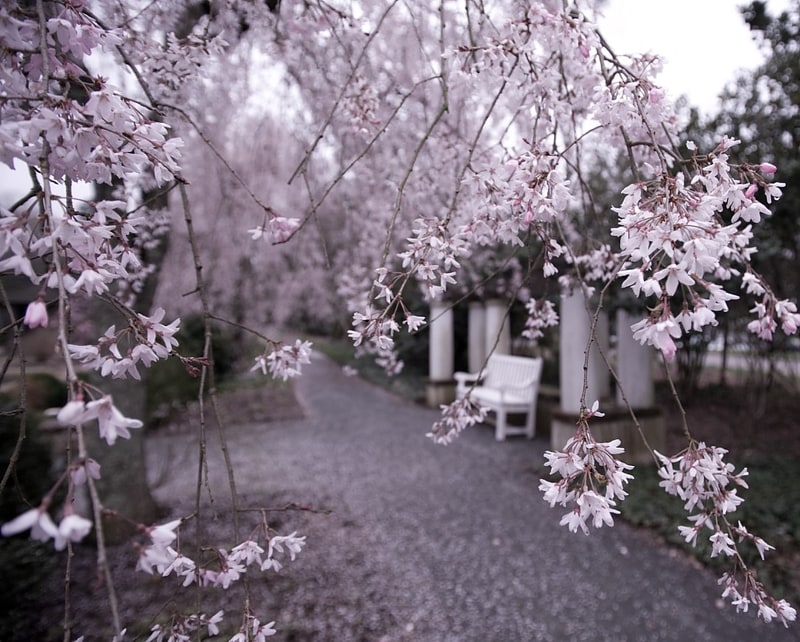
Botanical garden in Winston-Salem, North Carolina. Reynolda Gardens are located off Reynolda Road, adjacent to the Reynolda campus of Wake Forest University and the Reynolda House in Winston-Salem, North Carolina. The gardens are open daily with free admission.
The gardens were originally part of a large country estate and farm (1067 acres) created by tobacco magnate R. J. Reynolds and his wife Katharine Smith Reynolds between 1906 and 1923. In 1913 the Lord & Burnham greenhouse was built to serve the family and farm, and to produce flowers commercially. Landscape architect Thomas W. Sears (1880–1966) designed the 4-acre (16,000 m2) formal garden for Mrs. Reynolds, starting in 1915. After the death of Mrs. Reynolds (then remarried as Mrs. Johnston) in 1924, most of the property was gradually sold or given away, including a gift of 300 acres (1.2 km2) to Wake Forest College in the late 1940s for its Winston-Salem campus. In a series of gifts from 1958 to 1962, their daughter Mary Reynolds Babcock established Reynolda Gardens by donating its property to the college.
In 1995 the college and the National Park Service performed extensive historic reconstruction to return the garden to its original design.
Today the gardens include 125 acres (0.51 km2) of woodlands, fields, wetlands, and a 4-acre (16,000 m2) formal garden with greenhouse. Two acres of the formal gardens comprise the Greenhouse Gardens (designed 1917, 1920, 1931) which centers around a sunken garden divided into four quadrants, with grass lawns, border plantings, rose gardens, theme gardens, specimen trees, and boxwood hedges, as well as tea-houses, fountains, and pergolas. The other half contains the Fruit, Cut Flower, and Nicer Vegetable Garden (1921), which grows vines, vegetables, climbing roses, and espaliered fruit trees.
The entire property also includes a 3/4-mile woodland trail, as well as a slightly longer perimeter trail (1.5 miles).[11]
Address: 100 Reynolda Vlg, 27106-5123 Winston Salem
Winston-Salem City Hall
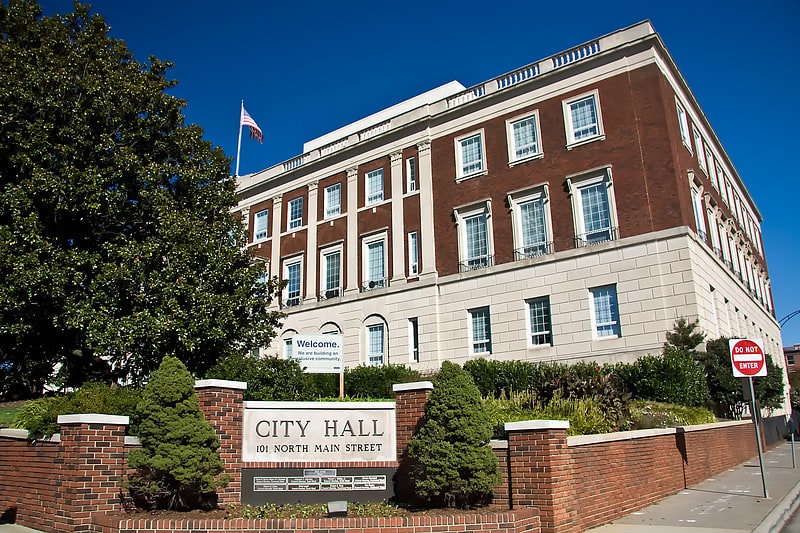
City or town hall in Winston-Salem, North Carolina. Winston-Salem City Hall is a historic city hall located at Winston-Salem, Forsyth County, North Carolina. It was designed by the architectural firm Northup and O'Brien and built in 1926. It is a three-story, "U"-shaped Renaissance Revival building. It is a brick building with a first floor of rusticated stone. It has a flat roof with a limestone cornice and balustrade with shaped balusters. The Salem town offices were housed in the Salem Town Hall until consolidation in 1913. The building was renovated in 2000.
It was listed on the National Register of Historic Places in 2001.[12]
Address: 101 North Main Street, Winston-Salem
Old Salem Museums & Gardens
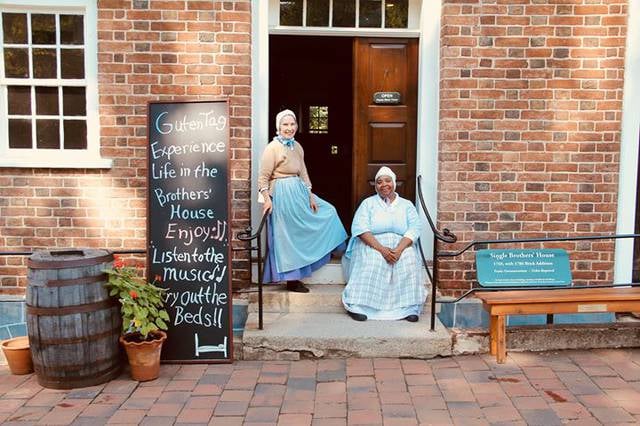
Museum, Historical place, History museum
Address: 900 Old Salem Rd, 27101-5277 Winston Salem
Salem Cemetery

Cemetery in Winston-Salem, North Carolina. The Salem Cemetery is located at 301 Cemetery St. in Winston-Salem, North Carolina.[13]
Address: 100-298 Cemetery St SE, 27101 Winston-Salem
The Coffee Pot

The Mickey Coffee Pot is a large tin coffee pot which is a local landmark in Winston-Salem, Forsyth County, North Carolina. The coffee pot was created in 1858 by tinsmiths Julius and Samuel Mickey as an advertisement for their tin shop on South Main Street. The pot is considered to be a symbol of hospitality and an unofficial symbol of the city.
The pot's original location on the curb caused it to be hit by wagons and cars. After the pot was damaged by a car in 1920, city officials attempted to keep the sign from being restored, as it was considered a safety hazard and illegal advertising. However, after local protest, the coffee pot was restored on a post farther from the street.
The pot was relocated in 1959 when then Interstate 40 (now US 421/"Salem Parkway") went through the shop's location and again when Old Salem Road was created in the 1960s and the roads were reconfigured. The structure of the Coffee Pot is owned by the City of Winston-Salem. It is located at the north end of Old Salem in a traffic island formed by Old Salem Road and Main Street.[14]
Downtown North Historic District
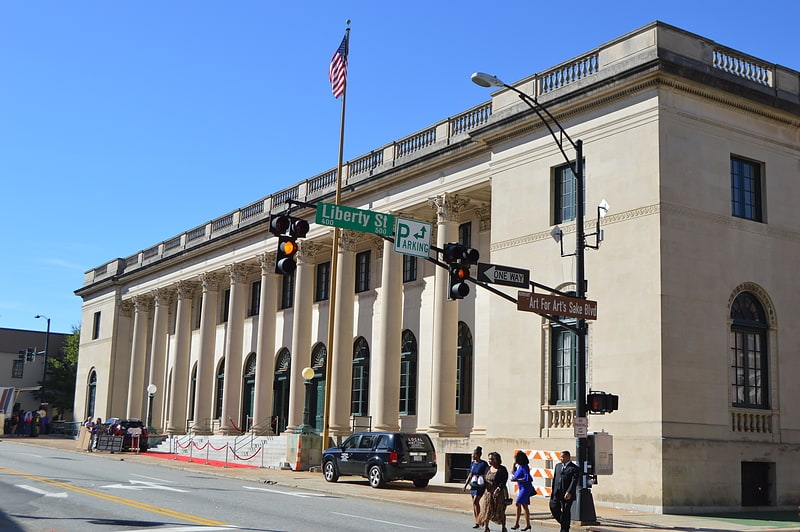
Downtown North Historic District, also known as Trade Street District, is a national historic district located at Winston-Salem, Forsyth County, North Carolina, USA. The district encompasses 46 contributing buildings in a commercial section of Winston-Salem. They were built between about 1907 and 1952, and most are one- or two-story brick buildings, sometimes with a stuccoed surface. Notable buildings include the Beaux-Arts style former United States Post Office with an addition by Northup and O'Brien, Brown-Rogers-Dixson Company Building, Centenary Church Education Building, Pure Oil Station, City Market, and Twin City Motor Company.
It was listed on the National Register of Historic Places in 2002.[15]
Address: Sixth and Trade Streets in Downtown, Winston-Salem
University of North Carolina School of the Arts
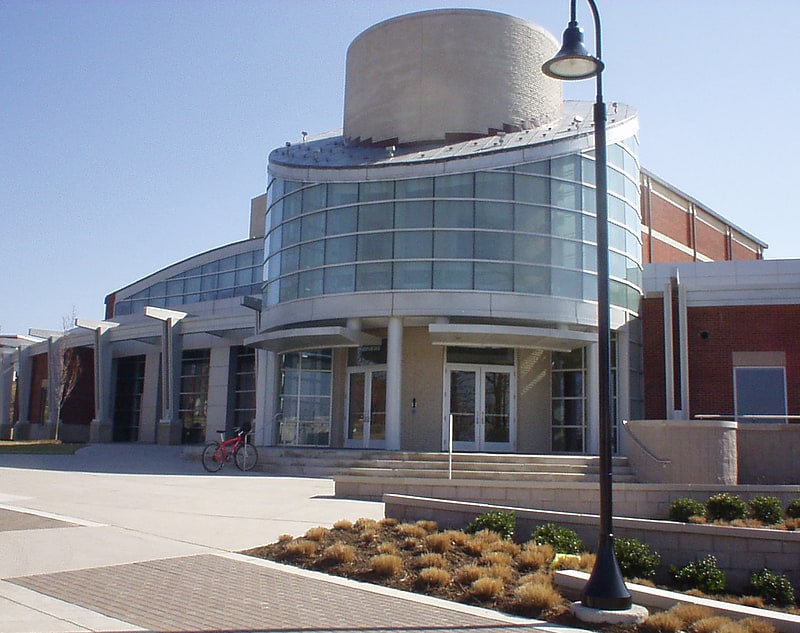
Art school in Winston-Salem, North Carolina. The University of North Carolina School of the Arts is an arts school in Winston-Salem, North Carolina. It grants high school, undergraduate, and graduate degrees. Founded in 1963 as the North Carolina School of the Arts by then-Governor Terry Sanford, it was the first public arts conservatory in the United States. The school owns and operates the Stevens Center in Downtown Winston-Salem and is accredited by the Southern Association of Colleges and Schools.
The school consists of five professional schools: School of Dance, School of Design & Production (including a HS Visual Arts Program), School of Drama, School of Filmmaking, and School of Music.[16]
Address: 1533 S Main St, Winston-Salem
Reynolds Building
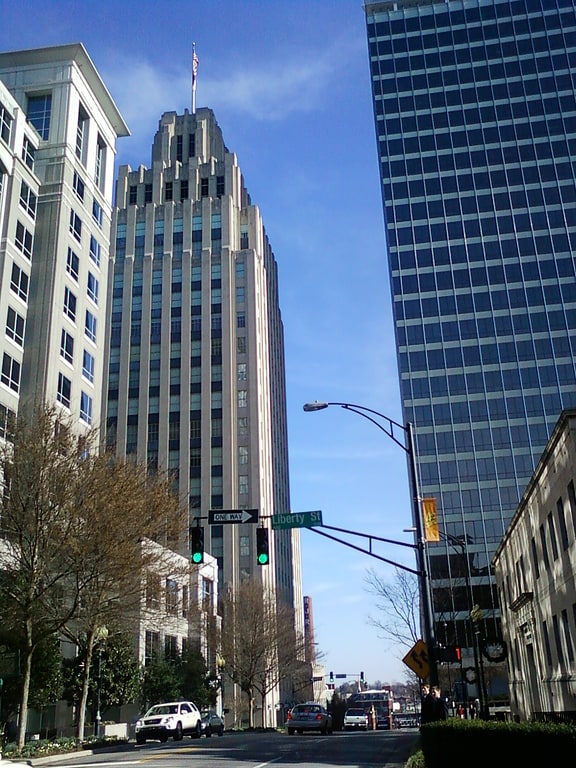
Building. The Reynolds Building is a 314-foot Art Deco skyscraper at 51 E. 4th Street in Winston-Salem, Forsyth County, North Carolina with 313,996 square feet of space. It was completed in 1929 and has 21 floors. For much of its history the building served as headquarters for R. J. Reynolds Tobacco Company. After a sale to PMC Property Group in 2014, the building went through an estimated $60 million in renovations. In March 2016, The Residences @ the R.J. Reynolds Building, apartments located on the top 11 floors, opened. The first six floors opened as the Kimpton Cardinal Hotel in April. Katharine Brasserie & Bar, a restaurant named for Katharine Smith Reynolds, followed in May.[17]
Goler Memorial African Methodist Episcopal Zion Church
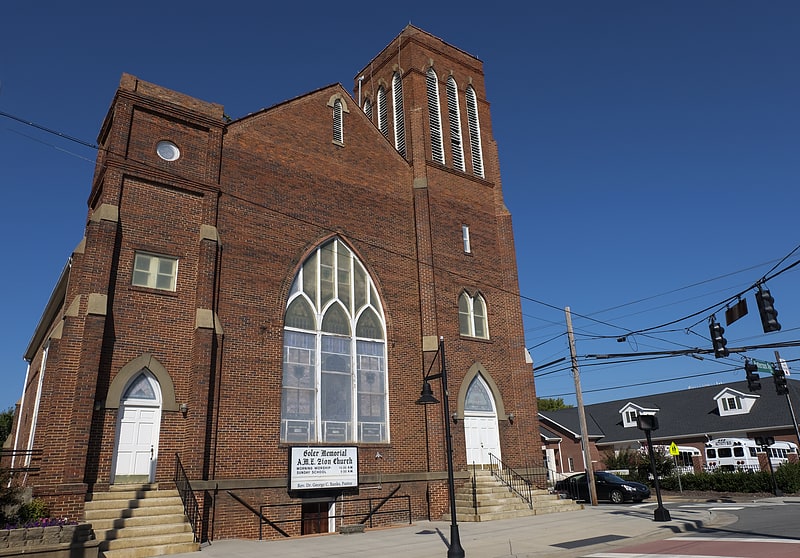
Church in Winston-Salem, North Carolina. Goler Memorial African Methodist Episcopal Zion Church, also known as Old Goler, is a historic African Methodist Episcopal Zion church located at 630 Patterson Avenue in Winston-Salem, Forsyth County, North Carolina. It was built in 1918–1919, and is a rectangular brick building in the Late Gothic Revival style. It features a gable-front block flanked by two square brick towers and stained glass windows. A two-story annex was built in 1946. In 1942, the Goler Metropolitan AME Zion Church congregation split from the Goler Memorial African Methodist Episcopal Zion Church.
It was listed on the National Register of Historic Places in 1998.[18]
Address: 620 Patterson Ave, 27101-4134 Winston-Salem
Bethabara Moravian Church
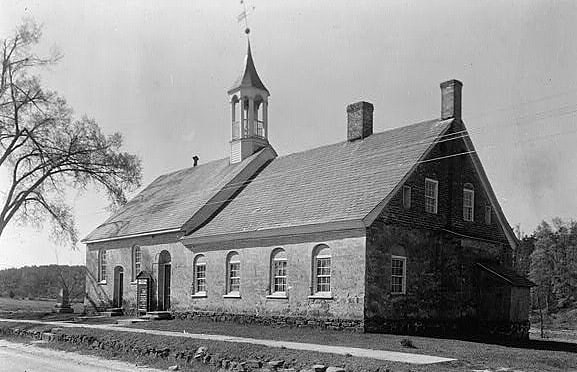
Moravian church in Winston-Salem, North Carolina. Founded as the first Moravian settlement in Wachovia on November 17, 1753, Bethabara served until 1766 as the center of Moravian work in the South. The old historic church was built in 1788.Designed by Moravian administrator Friedrich Wilhelm von Marschall, it is listed on the National Register of Historic Places. Bethabara Moravian Church facility was built in 1788 in what is now Winston-Salem, North Carolina.
It was listed on the National Register of Historic Places in 1971. The Bethabara Historic District, including the Church, were declared a National Historic Landmark in 1999.
The church is located at 2147 Bethabara Road. The congregation is still active, and meets down the road in an updated building at 2100 Bethabara Road, at the intersection with Indiana Avenue.[19]
Winston Cup Museum
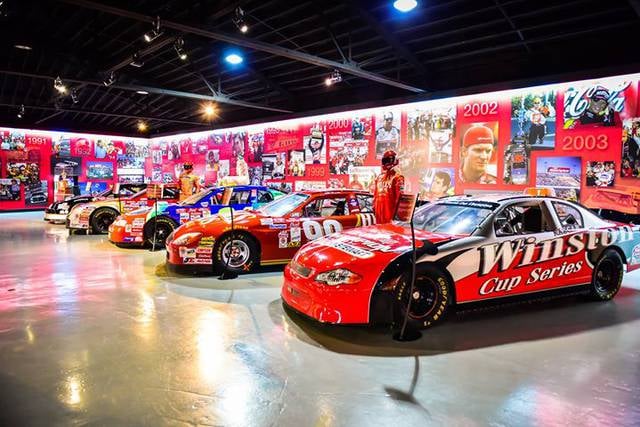
Museum, Specialty museum
Address: 1355 N Martin Luther King Jr Dr, 27101-3054 Winston Salem
Sawtooth School for Visual Art
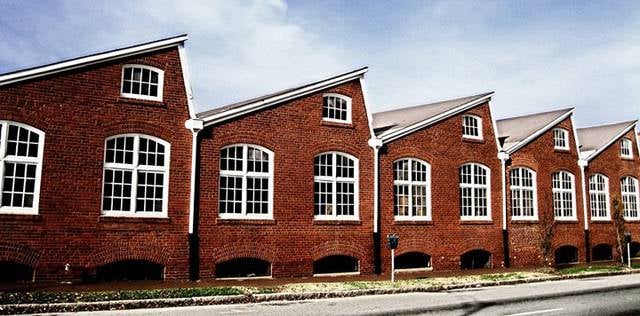
Museum, Universities and schools, Art gallery
Address: 310 N Marshall St, 27101 Winston-Salem
Delurk Gallery

Museum, Art gallery, Shopping
Address: 207 W 6th St, 27101-2901 Winston Salem
Fourth and Trade

Museum, Gift shop, Shopping
Address: 131 W 4th St, 27101-3808 Winston Salem
RJ Reynolds Auditorium
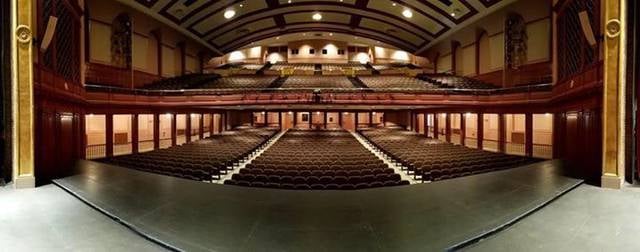
Building in Winston-Salem, North Carolina. The R. J. Reynolds Memorial Auditorium, located in Winston-Salem, NC, was built 1919–1924 under the direction of architect Charles Barton Keen. Keen also designed the adjacent Richard J. Reynolds High School. Both buildings are listed on the National Register of Historic Places.
The Auditorium and adjacent school sit on a tract of land formerly known as "Silver Hill." The 28-acre (110,000 m2) tract of land now encompasses the Auditorium, the school, Hanes Park (named after the founder of Hanes Clothing Company and then-mayor James G. Hanes), the Calvin H. Wiley Middle School and the Winston-Salem Central YMCA.
The Auditorium is now operated jointly by the Administration of the Richard J. Reynolds High School and the Winston-Salem/Forsyth County Schools. An auditorium manager is hired to take care of the day-to-day operations of the building and scheduling of performances and events.
The Auditorium is one of the oldest and largest performing arts centers in the City of Winston-Salem. The building can comfortably seat 1898 people, with 857 seats on the main Orchestra level and 1,041 seats located on the Mezzanine/Balcony area.[20]
Address: 301 N Hawthorne Rd, 27104-3201 Winston Salem
BB&T Financial Center
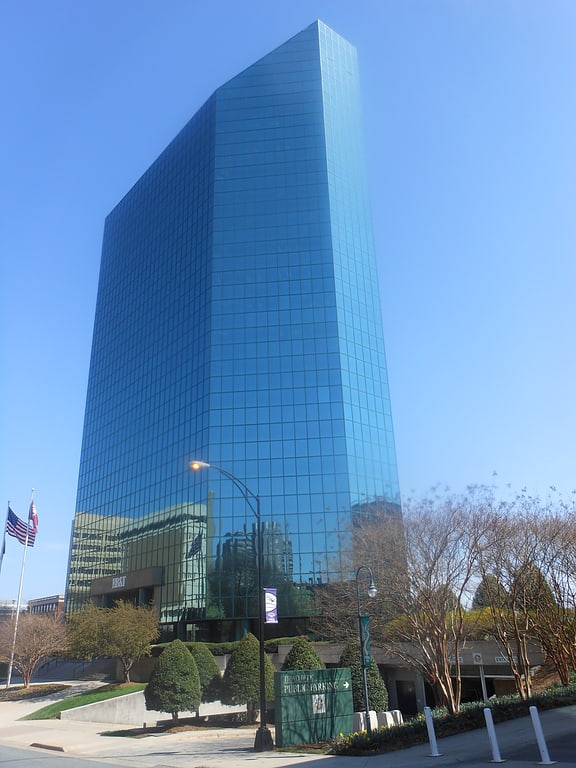
BB&T Financial Center is a 340-foot postmodern green glass and steel skyscraper at 200 West 2nd Street in Winston-Salem, Forsyth County, North Carolina, United States with 271,445 square feet of space. It was completed in 1987 and has 21 floors. It served as the headquarters of BB&T from the merger of BB&T and Southern National Bank in 1995. The 19th floor has The Piedmont Club, with 13,232 square feet feet.[21]
Mars Hill Baptist Church

Baptist church in Winston-Salem, North Carolina. Mars Hill Baptist Church, also known as Fries Memorial Moravian Church, is a historic African-American Baptist church located at Winston-Salem, Forsyth County, North Carolina. It was built in 1915, and is a "T"-shaped brick building with corner tower in the Gothic Revival style. Also on the property is the parsonage; a one-story, pebble-dash finished Queen Anne style dwelling. It has a high hipped roof, a central hipped dormer, and a hipped-roof full-front porch supported by fluted columns. It was originally built for a white Moravian congregation, until the Mars Hill Baptist Church congregation purchased the building in 1944 for $4,000.
It was listed on the National Register of Historic Places in 1999.[22]
Address: 1331 E 4th St, 27101-4319 Winston-Salem
Reynolda Village
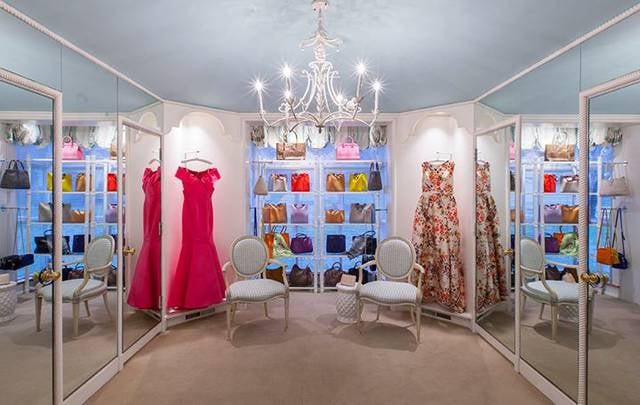
Reynolda Village is a shopping and business complex in Winston-Salem, North Carolina created from the servant and agricultural buildings of the former R. J. Reynolds estate, Reynolda. At present, it is owned and operated by Wake Forest University. It is the location of the first Village Tavern in the restaurant chain. Reynolda Gardens is adjacent to the village.[23]
Address: 107 Reynolda Village, Winston-Salem
Nissen Building
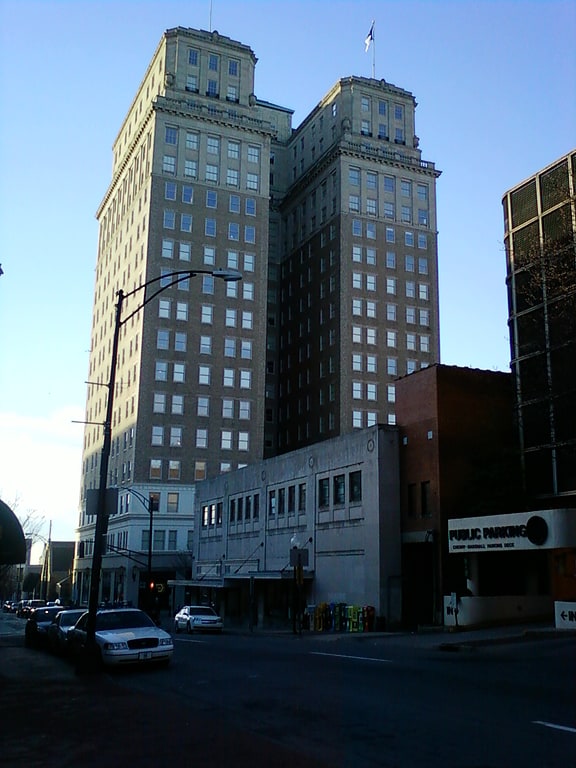
Building in Winston-Salem, North Carolina. The Nissen Building is a 283 ft 18-story skyscraper in Winston-Salem, Forsyth County, North Carolina, built in 1927. It was the largest building in the city, succeeding the Hotel Robert E. Lee, and the tallest building in North Carolina from 1927 to 1929, when it was succeeded by the Reynolds Building; all three buildings were in Winston-Salem. The Nissen Building was named to the National Register of Historic Places March 17, 1983, with a boundary increase in 2004 to include a one-story addition built in 1969. With the spire on top, its height is 102.1m.
It has a steel frame, with buff brick and pre-cast concrete for the exterior, along with details in granite, marble and limestone.[24]
Arista Cotton Mill Complex
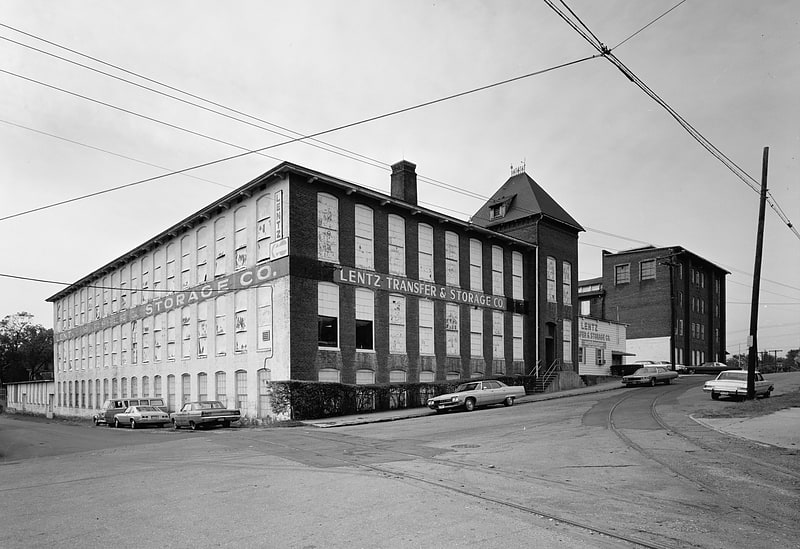
Arista Cotton Mill Complex, also known as Salem Cotton Manufacturing Company and Arista Cotton Mill and Lentz Transfer & Storage Co. is a historic cotton mill complex located at Winston-Salem, Forsyth County, North Carolina. The complex includes two buildings: a brick building built in 1836 by part of the Moravian congregation of Salem and the original home of the Salem Cotton Manufacturing Company, and the other is the original Arista Mill, built in 1880 by F. and H. Fries Cotton Arista Mills. The 1836 Salem Cotton Mill is a three-story, brick building with a monitor roof. The 1880 mill is a three-story brick building, 14 bays long, with bracketed eaves with timber supports. A two-story roughly triangular brick building was added about 1900. The 1836 building has been converted to a hotel known as The Historic Brookstown Inn.
It was listed on the National Register of Historic Places in 1977.[25]
8 West Third Street
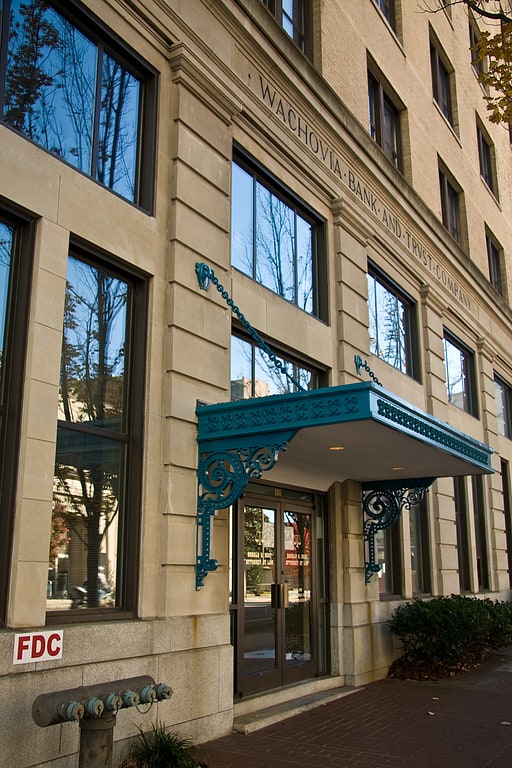
8 West Third Street is a 126 ft nine-story skyscraper in Winston-Salem, North Carolina, also known as the Wachovia Bank and Trust Company Building. It was built in 1911 as the headquarters of Wachovia Bank and Trust, with the ninth floor added in 1917. It was Winston-Salem's first steel frame skyscraper, built in the Renaissance Revival style, and it was the city's tallest building from 1911 until the O'Hanlon Building was built in 1915, and again from 1917 until the completion of Hotel Robert E. Lee in 1921. The Wachovia Bank and Trust Company Building served as the bank's headquarters until a new headquarters was built in 1966. It was named to the National Register of Historic Places on May 31, 1984, as "Wachovia Bank and Trust Company Building".
It was designed by Frank Pierce Milburn of Milburn, Heister & Company.
Wachovia House Inc. an affiliate of JDL Castle Corp. sold the building for $3 million to PMC Property Group in a deal completed December 7, 2021. Plans so far only include the name 8 W 3.[26]
Conrad-Starbuck House
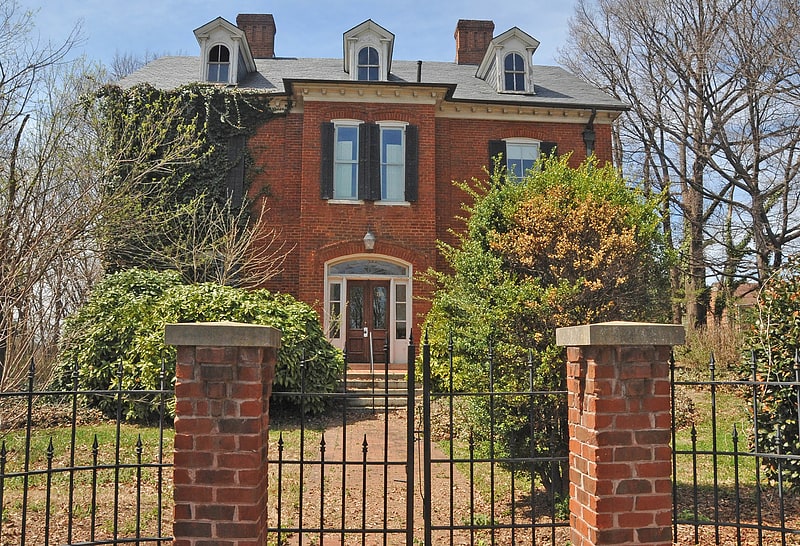
Conrad-Starbuck House is a historic home located at Winston-Salem, Forsyth County, North Carolina. It was built in 1884, and is a 2+1⁄2-story, three bay, double pile Italianate style brick dwelling. It has a number of rear additions. The central projecting bay once had a three-story tower, but the top level was removed between 1912 and 1917.
It was listed on the National Register of Historic Places in 1990. The property was purchased in 2019 by Spear Properties Group, with plans to renovate the house and surrounding land to fit historic roots. The house now serves as office suites for downtown Winston-Salem.[27]
O'Hanlon Building
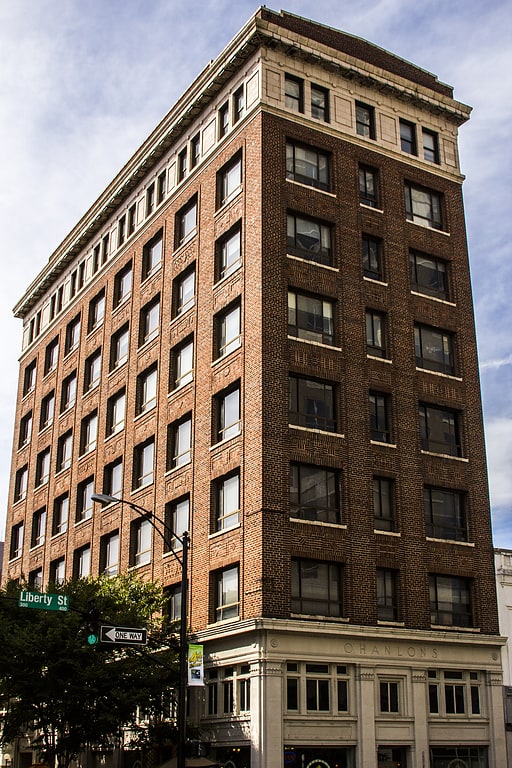
O'Hanlon Building is a historic commercial building located at Winston-Salem, Forsyth County, North Carolina. It was designed by architect Willard C. Northup and built in 1915. It is an eight-story, steel frame building clad in brick and terra cotta. It was Winston-Salem's tallest building until 1917, and is the city's second-oldest skyscraper. For many years, the first floor commercial space housed a drug store.
It was listed on the National Register of Historic Places in 1984.[28]
James Mitchell Rogers House

James Mitchell Rogers House is a historic home located at Winston-Salem, Forsyth County, North Carolina. It was built between 1883 and 1885, and is a large two-story, eclectic Late Victorian frame dwelling. The house design reflects Late Gothic Revival, Italianate, and Queen Anne style design influences. It features steeply pitched gables sheathed in board and batten siding, bay windows, and irregular massing. It was the home of James Mitchell Rogers, a prominent Winston-Salem businessman, and his son, Francis Mitchell Rogers, chief chemist of Standard Oil Company of Indiana.
It was listed on the National Register of Historic Places in 1982.[29]
Shamrock Mills
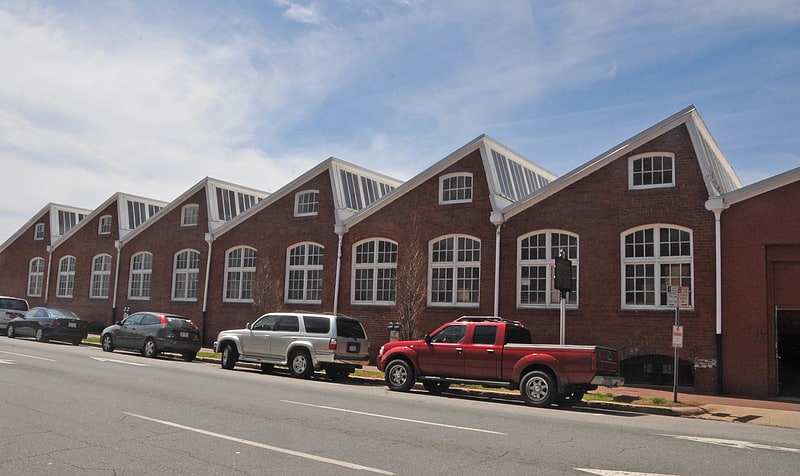
Shamrock Mills, also known as Hanes Hosiery Mill #1, is a historic textile mill building located at Winston-Salem, Forsyth County, North Carolina. It was built in 1911, and is a one-story brick building with daylight basement. It is six bays deep and extends in seven sections with a rhythmic saw-tooth roof and six-foot skylights. An addition was built in 1925. It was the first building used by the Hanes Hosiery Company. The mill closed in 1926, and the building subsequently housed a Cadillac dealership. The building houses the Sawtooth School for Visual Art.
It was listed on the National Register of Historic Places in 1978.[30]